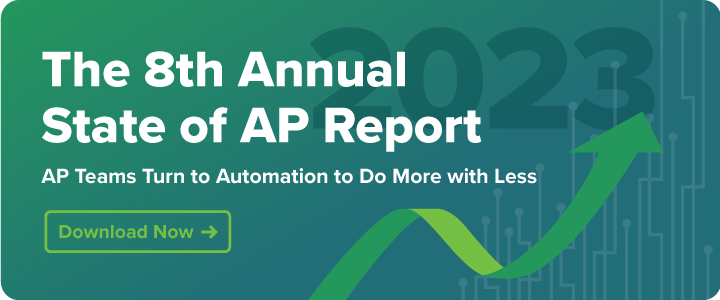If your manual, paper-based AP process lacks the data required to effectively track and analyze metrics and KPIs, you’re not alone. In fact, according to the Institute of Finance & Management, only 9% of respondents think that their method of measuring AP metrics and KPIs is extremely effective. When asked about their method for monitoring metrics and KPIs, 66% of businesses are still using Excel spreadsheets and 38% are using whiteboards/emails, or nothing at all.
What are Accounts Payable Metrics?
Accounts payable metrics are the benchmarks that highlight any inefficiencies within the AP process. These metrics can be anything from tracking the average cost per invoice to the number of electronic paper invoices captured.
How Can Accounts Payable Teams Improve Efficiency?
Businesses looking to improve AP efficiency should consider investing in an automated and paperless accounts payable process. By automating the end-to-end AP process, finance teams can take advantage of more efficient invoice approvals and payment executions. Additionally, their team will have access to more robust analytics and metric tracking that will allow them to approach AP more strategically.
For companies not ready to automate the AP function, they should at minimum be setting KPIs that align with their overarching business goals. They should determine the priorities of their organization which can range from vendor management to cash flow. AP teams must then match these business goals with their correlating metrics.
What are Accounts Payable Metrics Used For?
When properly tracked, accounts payable metrics and KPIs can be leveraged to inform strategic decisions, improve operations and processes, gain a greater understanding of suppliers, and take advantage of cost savings. By utilizing an AP automation platform with embedded analytics, AP managers can more easily track key metrics and identify patterns that drive smarter decision-making and success across the company.
How Do You Measure Accounts Payable Performance?
To evaluate AP performance, businesses must track and measure key performance indicators (KPIs). These KPIs include metrics such as the processing cost per invoice, invoice processing time, and the invoice error rate. Evaluating the performance of each of these aspects will help your business assess the effectiveness, efficiency, and level of compliance within your AP process, as well as help you identify areas for improvement that will save your company time and money. There are several ways to measure accounts payable performance depending on the type of metric used.
Here are 10 of the most important AP metrics to track to measure performance accurately and optimize AP efficiency. However, AP performance goals should be determined based on the overarching business objectives. These can include:
- Improved Productivity across the Financial Department
- Improved Vendor Relationships
- Better Cash Flow Management
- More Accurate Accounts Payable Forecasting
Creating AP Goals
Before determining what goals to pursue, it’s important to take the following steps:
Audit the Existing Account
Without a comprehensive overview of the current state of your AP team, it’s difficult to understand what processes can be improved. An AP automation tool can make it easier to gain visibility into the current process.
Align AP Goals with Business Objectives
As noted above, AP goals should be aligned with overarching business objectives. Metrics for success should align with the business goals. This can include a shorter DPO in the case of improving vendor relationships or negotiating a longer DPO in the case of cash flow management objectives.
Set Up SMART Goals
SMART goals in AP are a framework that can be used to set achievable, measurable, time-bound, and relevant goals for your organization. These goals are designed to help your business achieve desired results and can be applied to any area of your business and accounts payable department.
In order to set up smart goals for your business, you must first identify the areas where you want to improve. Once you have a clear idea of these areas, you can start setting specific, measurable, achievable, relevant, and time-bound goals. For example, reducing invoice processing time by 10% within the next three months would be a SMART goal for your AP department.
Examples of Accounts Payable Goals & Metrics
1. Total Number of Invoices Received
Your team should be tracking the number of invoices received during a given time period. This time period can be daily, weekly, monthly, or yearly — whatever makes the most sense based on the volume at your organization. By tracking this metric, you can start to plan appropriately. For example, if you know Q4 has a particularly high volume of invoices coming in, you can bring on more staff or automate your process so you’re better equipped to handle the spike.
2. Total Number of Invoices Processed
You also need to count how many invoices your team can process in that same time period. If the number is low, this is likely a sign that there are bottlenecks in your AP process that are affecting your level of efficiency and ability to process invoices on time. Consider the ramifications of continuing with a manual invoice approval. It might be time for an AP automation solution to speed up the process.
3. Average Cost per Invoice
Total AP Costs ÷ Number of Invoices Processed = Average Cost per Invoice
The average cost per invoice indicates how much it costs, on average, to process a single invoice. Using insights gained from this calculation can further help organizations determine labor costs (hours worked and the personnel involved), accounts payable infrastructure costs (tools and software used), paper check and envelope costs, and postage fees. AP leaders can choose to cut out any unnecessary costs and adopt virtual card payments to keep this number down.
4. Average Time Taken to Process an Invoice
Time Spent Processing Invoices ÷ Number of Invoices Processed = Average Processing Time per Invoice
This is a metric that tells you how long it takes, on average, to process a given invoice. Understanding your average invoice processing time can help reveal gaps in efficiency. The longer it takes to process a single invoice, the more costly invoice processing becomes due to associated labor costs. This metric should be analyzed alongside average cost-per-invoice to help determine where improvements can be made.
5. Rate of Error as a Percentage of Total Invoices Paid
Number of Incorrect Payments ÷ Number of Invoices Paid = Rate of Error
The rate of error allows your team to identify the number of payment errors they have made in a given time period. This metric is critical to track because erroneous payments, duplicate payments, or overpayments can drain your company’s finances over time. Strive to keep this number as low as possible and identify what could be causing these payment errors.
6. Discounts Captured & Obtained as a Percentage of Discounts Offered
Number of Discounts Captured ÷ Number of Discounts Offered = Discounts Captured as a Percentage of Discounts Offered
This metric refers to how many early payment discounts your business secured in relation to how many were offered to you. It helps track missed opportunities and the amount of money you could have saved had you been able to make an early payment. You can also identify reasons why your company may be failing to take advantage of these offers, such as a lack of manpower or employee support that could be remedied with an automated solution.
Quartzy, a life science product distributor, offers customers the ability to purchase from over 10 million products. By leveraging MineralTree’s SilverPay virtual card, they were able to take advantage of virtual card rebates. They are on track to earn $100,000, which allows the AP team to make a significant contribution to the company’s bottom line.
7. Number of Electronic vs. Number of Paper Invoices Captured
The goal of this metric is to understand the percentage of suppliers who are sending your company electronic invoices so that you are equipped to deal with them, whether it’s through the invoice capture capabilities of an AP automation solution or through ERP integration. Electronic invoices are cheaper and quicker to process and encouraging suppliers to send e-invoices helps keep overall costs down.
8. Payables Aging or Days Payable Outstanding (DPO)
Accounts Payable x Number of Days ÷ Cost of Goods Sold (COGS) = DPO
This is a metric that tells you the average number of days it takes for your company to pay back your suppliers for services rendered. A high Days Payable Outstanding (DPO) can be advantageous to a company’s cash flow because it means extra cash-on-hand for short-term activities, but it can also mean that you’re not paying suppliers on time. If suppliers are continuously being paid late, it can cause a strain in your relationship and they may not want to work with you in the future.
9. Mix of Payment Types
How many different payment types is your team collecting or putting out in a given period? Whether it’s through checks or electronic payments like ACH, virtual card, or wire transfers, it’s important to understand your payments mix. One of the challenges associated with using multiple payment types is that without an AP automation platform, you often need a separate, manual process for handling each of them, requiring more manpower and time. With an understanding of your payments mix, you can allocate staff and resources appropriately.
Below are some of the top reasons to optimize your payments mix:
- Save costs: Paper checks are expensive, costing about $5.00 per invoice. For every 1,000 invoices processed, that’s $5,000 companies could be saving. However, despite these costs, 33% of companies are making the majority of their payments via check. By tracking this metric, your team can determine how much invoice payments are costing your company and how these costs can be reduced.
- Reduce The Number of Processes Needed: Separate processes and payment methods often require different workflows. By tracking the payment mix, your team can determine how many workflows are in place. For companies who are worried about managing separate processes, it may be worth investigating AP workflow automation. An AP automation platform, such as MineralTree, allows your vendors to get paid in their preferred method without creating additional processes or workflows.
- Become more strategic: Additionally, your team can take advantage of more electronic payments, which cost less money for your organization. By determining the current payments mix and the number of invoices, your team can determine which vendors to prioritize for digital payments.
A virtual card like SilverPay allows companies to process all their payments in an automated system that fits into most existing AP workflows, enables you to pay suppliers faster and ensures maximum security. With virtual cards, there is also an opportunity to take advantage of early payment discounts and cash-back rebates which can have a positive impact on cash flow. Additionally, MineralTree helps enroll suppliers into this form of electronic payments, eliminating this manual process from your AP team.
10. Spend by Vendor
It’s no secret that vendor relationships are important in today’s business. In fact, 58% of survey respondents noted that supplier relationships had become more strategic over the last year. In certain industries such as healthcare, this number was even higher (73%). By tracking spend by vendor, your AP team can determine which suppliers are most critical to your business. This metric allows your team to take a more strategic approach to AP, by focusing on how the financial function can support the whole business by improving important vendor relationships.
Case Study: Simple Mills Uses AP Analytics to Make More Strategic Decisions
Simple Mills, a food company specializing in crackers, cookies, snack bars, and baking mixes made with nutrient-dense ingredients, was looking for a way to optimize manual AP tasks. When Simple Mills approached MineralTree, they had one person handling 1,000 invoices a month. However, as the company was continuing to grow, they needed a solution that would scale with them.
In addition to the suite of capabilities that MineralTree offers, such as a two-way sync with Netsuite and invoice captures that boast 99.5% accuracy, Simple Mills was able to take advantage of powerful AP analytic tools. They could use important metrics such as spend-by-vendor to create models to outline how changes in AP could impact the business. “We look at what could happen if we extend payment terms or ask for early-pay discounts with certain suppliers,” said Maddy McGannon, Simple Mills’ Controller. “MineralTree gives us the insight to analyze our payment data and use it to improve business decision-making.”
They also use AP analytics to determine approval threshold and steps in their payment process. Leveraging data is helping Simple Mills scale their AP, while ensuring the company can allocate employee time efficiently.
How to Simplify KPI Reporting and Analytics with AP Automation
At the end of the day, the more accounts payable metrics you track, the more data and information you have at your fingertips to make smarter business decisions. Take the time to look at your metrics and identify areas of your AP process that might be slowing down your business. Also, take note of the metrics you are not currently tracking, but should. If you’re looking for a simple way to improve business processes, it could be time to consider an AP automation solution with embedded analytics. By utilizing AP analytics, AP managers have access to high-quality data that not only drives better decision making, but enables users to optimize their accounts payable process and improve their KPIs.
Ready to learn more about how to start tracking AP metrics with an automated solution? Request a demo today!
Accounts Payable Metrics Frequently Asked Questions
What are Accounts Payable Metrics?
Accounts payable metrics are key performance indicators (KPIs) that highlight any inefficiencies within the AP process. These metrics can be anything from tracking the average cost per invoice to the number of electronic paper invoices captured.
What Are Accounts Payable Goals?
AP goals are metrics that help the finance team manage their invoice payments more optimally. These goals can range from maximizing rebates to optimizing DPO. Organizations should consider their overall business goals when selecting the right KPIs and metrics for determining the success of the accounts payable department. By selecting the right goals, companies can ensure they are managing their accounts payable departments effectively.
How Do You Analyze Accounts Payable?
Accounts payable should be analyzed in conjunction with overarching business goals. For companies who place a high worth on strategic supplier partnerships, AP teams may choose metrics that improve these relationships. For companies looking to make short-term investments, AP departments may focus on cash flow.
What are the Most Important AP Metrics to Track?
The 10 most important AP metrics to track include:
- Total Number of Invoices Received
- Total Number of Invoices Processed
- Average Cost Per Invoice
- Average Time Taken to Process an Invoice
- Rate of Error as a Percentage of Total Invoices Paid
- Discounts Captured & Obtained as a Percentage of Discounts Offered
- Number of Electronic vs. Number of Paper Invoices Captured
- Payables Aging or Days Payable Outstanding
- Mix of Payment Types
- Spend by Vendor
How Do You Optimize Accounts Payable?
The easiest way to optimize AP is by implementing an end-to-end accounts payable solution, that will reduce manual processes for your team. Employees can then focus on more strategic initiatives that contribute to the bottom line, such as vendor relationships. Additionally, AP automation platforms such as MineralTree will feature a set of sophisticated AP analytics that will help your team make better decisions related to vendor payments and payment mix.
What Are the Biggest Challenges in Accounts Payable?
For teams looking to manage accounts payable effectively, the following are challenges:
- Manual and time-consuming processes
- The ability to scale the AP function
- Insight into vendor payment
- Improving relationships with vendors
What are Accounts Payable Metrics and KPIs Used For?
Accounts payable metrics and KPIs can be leveraged to inform strategic decisions, improve operations and processes, gain a greater understanding of suppliers, and take advantage of cost savings.
What is an Accounts Payable Metrics Dashboard?
An accounts payable metrics dashboard is a visual representation of the KPIs a business has identified. KPIs included in the AP metrics dashboard include days payable outstanding (DPO), invoice error rate, invoice processing time, cost per invoice processed, the AP aging report, and percentage of supplier discounts acquired. Some AP automation solutions, like MineralTree, have dashboards and analytics included in the platform, making it easy to report on the health of your existing AP process and identify areas where it can be improved.
What Are SMART Goals?
SMART goals are specific, measurable, achievable, relevant, and time-bound.
What is Goal Setting in Accounts Payable?
Goal setting in accounts payable (AP) is identifying and defining specific, measurable, achievable, relevant, and time-bound (SMART) objectives for the AP department. These goals should be aligned with the overall goals of the company and should be designed to improve the efficiency and effectiveness of the AP process.
What Are the Metrics for Vendor Performance?
Vendor performance metrics are quantifiable indicators that measure how well a vendor is meeting their contractual obligations and performance expectations. These metrics can be used to track their performance over time, help make informed decisions about vendor relationships, and identify areas of improvement. Some common vendor performance metrics include compliance rate, on-time delivery rate, and product/service quality rate.
What Metrics Do CFOs Care About?
CFO metrics and KPIs are used to provide a clear overview of the financial health of a company. CFOs care about a number of metrics and KPIs, including revenue growth rate, gross profit margin, and EBITDA.




